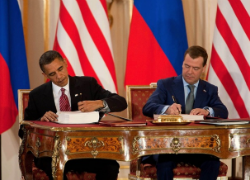When the Constitution was originally drafted, the Founders thought it appropriate to give the president the power to make treaties with other nations. However, the president’s power was restricted; under Article 2, Section 2 of the U.S. Constitution, the president could only make a treaty by and with the advice and consent of the Senate. Additionally, a never easy two-thirds senate approval was required. Without the approval, the President did not have the authority to enter into a treaty with any other sovereign nation. The treaty process is the same today. Yet, there seems to be another means of obtaining similar results: an executive agreement. The Constitution does not provide any process in which an executive agreement must be conducted. Rather, the practice of conducting executive agreements has been validated (to what extent is unclear) through rulings of the Supreme Court and the practice of the political branches. The question I am asking is: how broad is the president’s power to use executive agreements, and what are the future implications of that power?

Image Source: Wikimedia Commons
Treaties and executive agreements are drafted and signed many times each year. Originally, treaties were much more common than executive agreements; however, that is not the case today. After WWII, the executive agreements were used much more frequently than treaties. Many believed this was because of the increasing difficulty to get a two-thirds senate approval. The president has the ability to enter into sole executive agreements without any approval from the House or Senate. The shift from treaties to executive agreements has arguably eliminated the checks and balances the founders, when drafting the treaty clause, intended to put upon the executive branch. The countering argument is that the founders intended to give the president a broader grant of power when they added the vesting clause to the Constitution.
Executive agreements appear to have the same effect as treaties. They are binding upon both parties, and the Supreme Court has found them to preempt state law. This leads to the question of how broad is the president’s powers in entering into executive agreements? There seems to be some constraint upon which issues the president can execute sole executive agreements. The limitation appears to limit the subject matter to issues in which the president already has the power to direct, namely foreign affairs. The president cannot use a sole executive agreement to usurp congressional powers; however, the court has not dealt with this question directly.
What this all means is still unclear. But one thing that is certain is there will be uncertainty moving forward. Over the past few years, we have seen the issue come up time and time again. In 2009, President Obama declared he would temporarily bypass Senate ratification if a Russian Arms treaty was not ratified (it eventually was ratified in 2010), showing that he believed he had the power to bypass the requirements of the treaty clause. Specifically, he believed he could use an executive agreement when dealing with Arms relations internationally, something that had only previously been done through treaties.
President Obama’s belief that he has great autonomy in using executive agreements was shown recently in his speech at the White House addressing the conflict in Syria. President Obama stated, “Yet, while I believe I have the authority to carry out this military action without specific congressional authorization, I know the country will be stronger if we take this course, and our actions will be even more effective.” Though it appears the President believes he has complete autonomy in using executive agreements, other factors are considered when making the decision of whether or not to include other branches of the government for approval. Other controversial uses of this power have been the Anti-Counterfeiting Trade Agreement signed in 2011, which potentially would authorize foreign companies to effectively remove web content in the United States without legal oversight. Additionally, the Afghanistan Bilateral Security Agreement could potentially put troops overseas for another 10 years without a two-thirds senate approval.
In the end, giving the president this power appears to be what the legislative and judicial branches are wanting, or at very least accepting. There doesn’t seem to be much fight regarding where the president is deriving the power to enter into such agreements. It appears the only source of power is derived from past practices and the vesting clause in the Constitution, but to what limits? Which begs the questions, why isn’t there more of a fight from the legislative branch to restrict the president’s power? How far will the power be allowed to go, and at what point will the president’s power be constrained? Only time will tell the role of the treaty clause moving forward. Will it be set aside while executive agreements take control? Or will there continue to be a middle ground where both have a place in foreign affair relations?
Brixton Hakes is a second year law student and a Staff Editor on the Denver Journal of International Law and Policy

